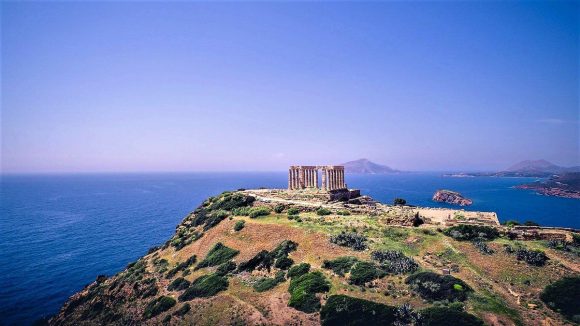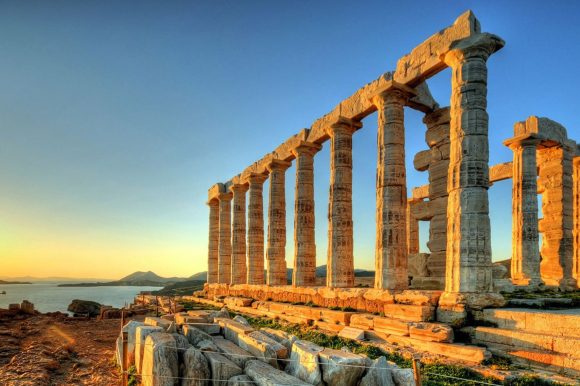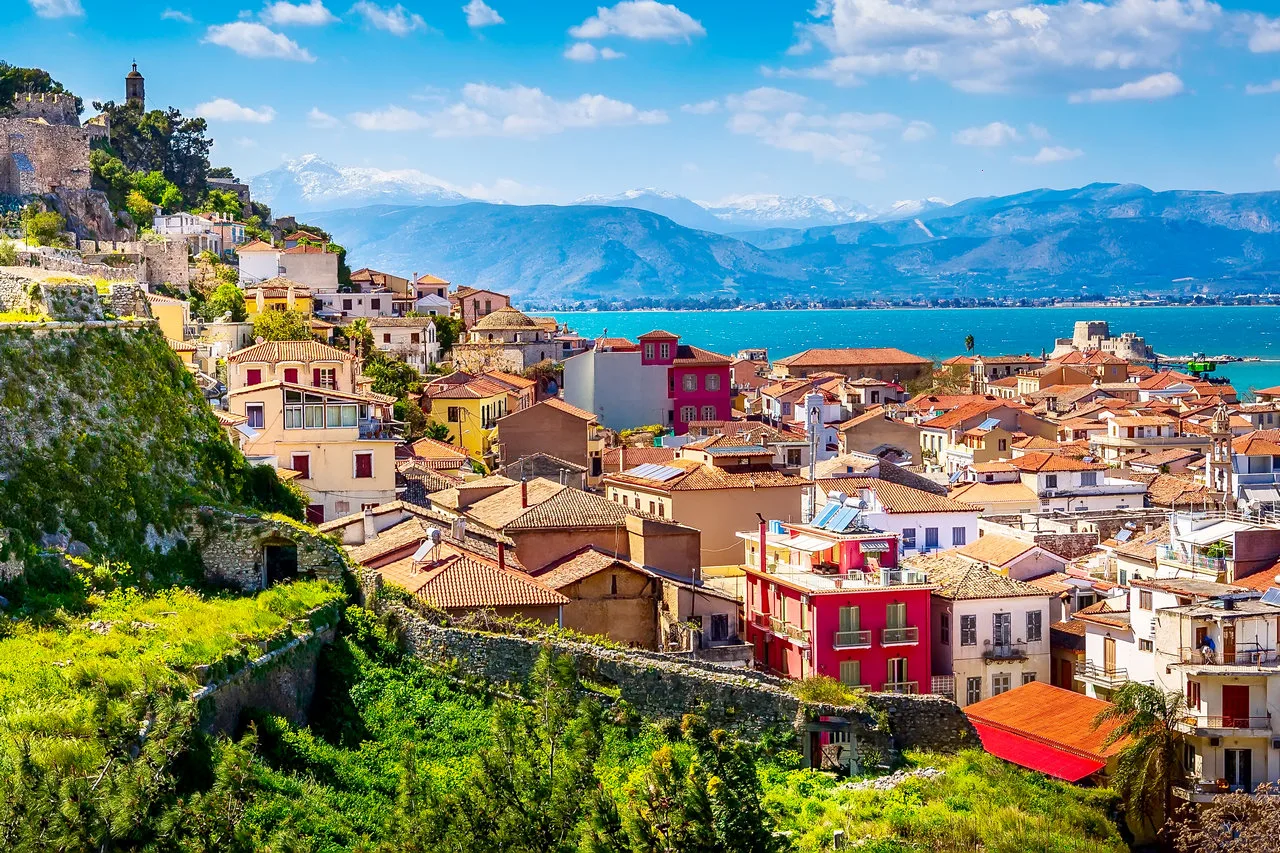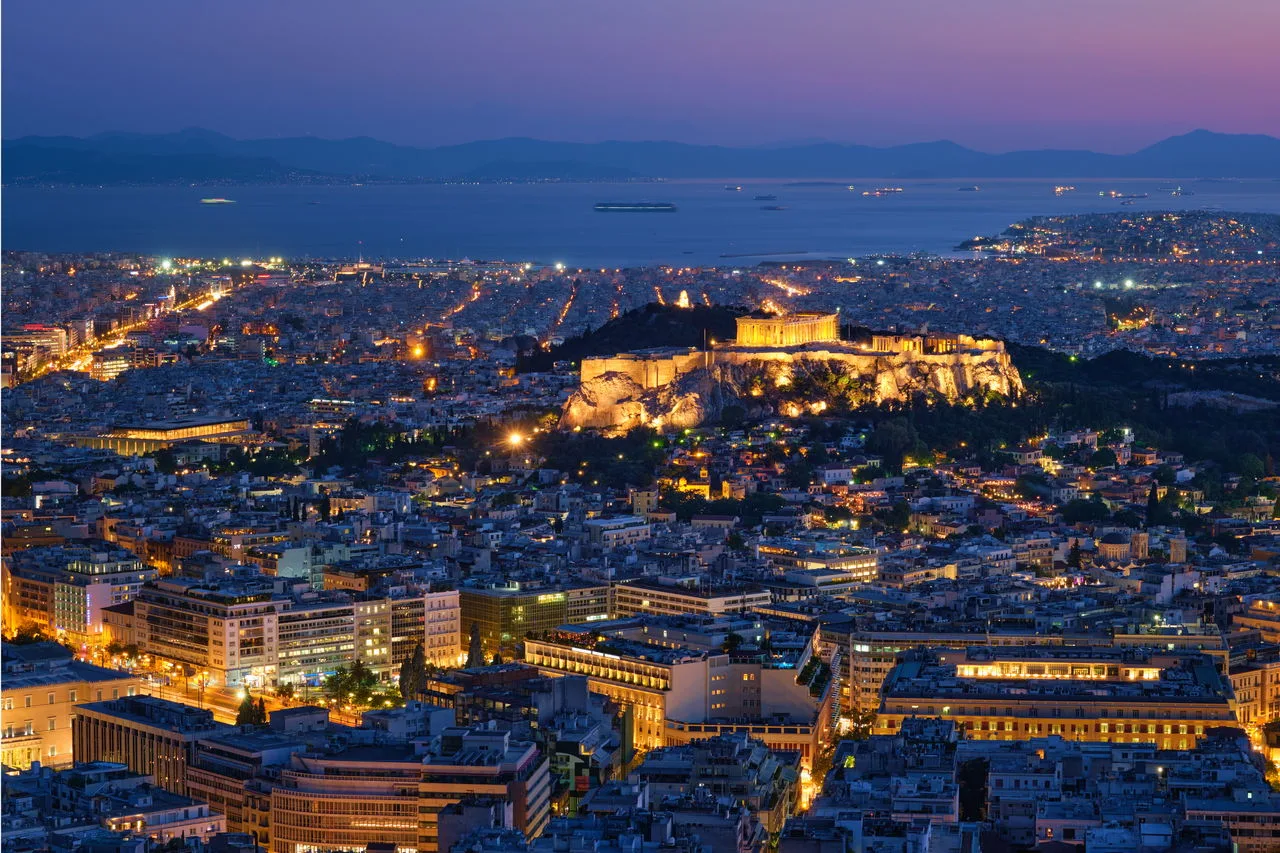Cape Sounion the significant strategic point of Athens 5C BC
Cape Sounion the significant strategic point of Athens 5C BC; Cape Sounion (Modern Greek: Aκρωτήριο Σούνιο – Akrotírio Soúnio; Ancient Greek: Άκρον Σούνιον – Άkron Soúnion; Latin: Sunium promonturium; Venetian: Capo Colonne – “Cape of Columns”) is a promontory located 69 km (43 mi, by road) SSE of Athens, at the southernmost tip of the Attica peninsula in Greece.
Cape Sounion is noted as the site of ruins of an ancient Greek temple of Poseidon, the god of the sea in classical mythology. The remains are perched on the headland, surrounded on three sides by the sea. The ruins bear the deeply engraved name of English Romantic poet Lord Byron (1788–1824).
The site is a popular day-excursion for tourists from Athens, with the sunset over the Aegean Sea, as viewed from the ruins, a sought-after spectacle.
Cape Sounion, Theseus and King Aegeus

According to legend, Cape Sounion is the spot where Aegeus, king of Athens, leapt to his death off the cliff, thus giving his name to the Aegean Sea. The story goes that Aegeus, anxiously looking out from Sounion, despaired when he saw a black sail on his son Theseus’s ship, returning from Crete. This led him to believe that his son had been killed in his contest with the dreaded Minotaur, a monster that was half man and half bull. The Minotaur was confined by its owner, King Minos of Crete, in a specially designed labyrinth. Every year, the Athenians were forced to send 7 boys and 7 girls to Minos as a tribute. These youths were placed in the labyrinth to be devoured by the Minotaur. Theseus had volunteered to go with the third tribute and attempt to slay the beast. He had agreed with his father that if he survived the contest, he would hoist a white sail. In fact, Theseus had overcome and slain the Minotaur, but tragically had simply forgotten about the white sail.
Homer’s poem the Odyssey
The earliest literary reference to Sounion is in Homer’s poem the Odyssey, probably composed in the 8th century BC. This recounts the mythical tribulations suffered by Greek hero Odysseus in a gruelling 10-year sea-voyage to return to his native island, Ithaca in the Ionian sea, from the sack of Troy. This ordeal was supposedly inflicted upon him by Poseidon, to whom the temple at Sounion was dedicated.
We are told that, as the various Greek commanders sailed back from Troy, the helmsman of King Menelaus of Sparta’s ship died at his post while rounding “holy Sounion, the cape of Athens”. Menelaus landed at Sounion to give his companion full funeral honours (i.e. cremation on a funeral pyre on the beach). The Greek ships were then caught by a storm off Cape Malea and scattered in all directions.
History of Sounion
Archaeological finds on the site date from as early as 700 BC. Herodotus tells us that in the sixth century BC, the Athenians celebrated a quadrennial festival at Sounion, which involved Athens’ leaders sailing to the cape in a sacred boat.
The original, Archaic Period temple of Poseidon on the site, which was built of tufa, was probably destroyed in 480 BC by Persian troops during Xerxes I ‘s invasion of Greece (the second Greco-Persian War). Although there is no direct evidence for Sounion, Xerxes certainly had the temple of Athena, and everything else, on the Acropolis of Athens, razed as punishment for the Athenians’ defiance. After they defeated Xerxes in the naval Battle of Salamis, the Athenians placed an entire enemy trireme (warship with three banks of oars) at Sounion as a trophy dedicated to Poseidon.
The later temple at Sounion, whose columns still stand today, was probably built in ca. 440 BC. This was during the ascendancy of Athenian statesman Pericles, who also rebuilt the Parthenon in Athens.
In 413 BC, during the Peloponnesian War against the Spartans, the Athenians fortified the site with a wall and towers, to prevent it from falling into Spartan hands. This would have threatened Athens’ seaborne grain supply route from Euboea. Athens’ supply situation had become critical, since the city’s land supply – lines had been cut by the Spartan fortification of Deceleia, in north Attica.[6] However, not long after, the Sounion fortress was seized from the Athenians by a force of rebel slaves from the nearby silver mines of Laurium.
Ancient Greek religion
Ancient Greek religion was essentially propitiatory in nature: i.e., based on the notion that to avoid misfortune, one must constantly seek the favour of the relevant gods by prayers, gifts and sacrifices. To the ancient Greek, every natural feature, e.g. hill, lake, stream or wood, was controlled by a god. Thus a person about to swim in a river, for example, would say a prayer to the river-god, or make an offering to that god’s shrine, to avoid the chance of drowning. The gods were considered immortal, could change shape, become invisible and travel anywhere instantaneously. But in many other respects, they were considered similar to humans. They shared the whole range of human emotions, both positive and negative. Thus, in their attitudes towards humans, they could be both benevolent and malicious. As humans also, they had family and clan hierarchies. They could even mate with humans, and produce demi-gods.
In a maritime country like Greece, the god of the sea was bound to occupy a high position in the divine hierarchy. In power, Poseidon was considered second only to Zeus (Jupiter), the supreme god himself. His implacable wrath, manifested in the form of storms, was greatly feared by all mariners. In an age without mechanical power, storms very frequently resulted in shipwrecks and drownings.
The temple of Poseidon
The temple at Sounion, therefore, was a venue where mariners, and also entire cities or states, could propitiate Poseidon, by making animal sacrifice, or leaving gifts.

The temple of Poseidon was constructed in approx. 440 BC, over the ruins of a temple dating from the Archaic Period. It is perched above the sea at a height of almost 60 m. The design of the temple is a typical hexastyle i.e. it had a front portico with 6 columns. Only some columns of the Sounion temple stand today, but intact it would have closely resembled the contemporary and well-preserved Temple of Hephaestus beneath the Acropolis, which may have been designed by the same architect.
As with all Greek temples, the Poseidon building was rectangular, with a colonnade on all four sides. The total number of original columns was 42: 18 columns still stand today. The columns are of the Doric Order. They were made of locally quarried white marble. They were 6.10 m (20 ft) high, with a diameter of 1 m (3.1 ft) at the base and 79 cm (31 inches) at the top.
At the centre of the temple
At the centre of the temple, colonnade would have been the hall of worship (naos), a windowless rectangular room, similar to the partly intact hall at the Temple of Hephaestus. It would have contained, at one end facing the entrance, the cult image, a colossal, ceiling – height (6m) bronze statue of Poseidon. Probably gold-leafed, it may have resembled a contemporary representation of the god, appropriately found in a shipwreck, shown in the figure above. Poseidon was usually portrayed carrying a trident, the weapon he supposedly used to stir up storms.
Archaeological excavation of the site in 1906 uncovered numerous artefacts and inscriptions, most notably a marble kouros statue and an impressive votive relief, both now in the Athens National Archaeological Museum.
Visit Sounion with our tours:







